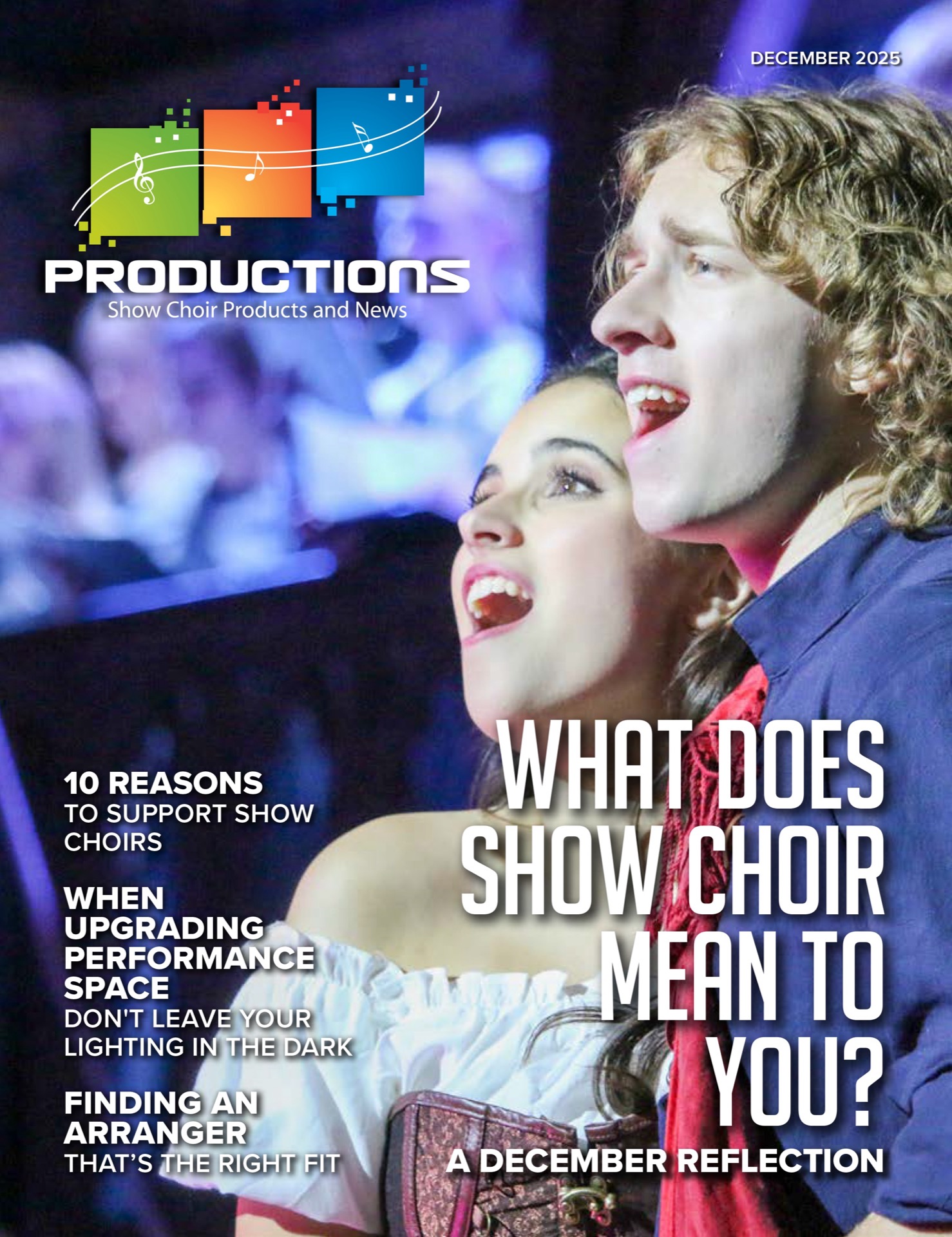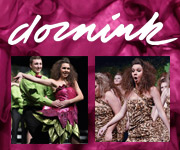
We spoke to Lanoue right in the middle of production season as he and his team were working around the clock to keep orders moving and every detail just right. Here’s what he shared about the art of advising clients, getting period pieces right, and what trends he sees for 2026.
Productions: What is one of the big trends you’re seeing right now in show choir costumes?
Lanoue: Something I’m seeing more of this year is going back to group looks, whether it’s the entire group in the same thing; the girls in one thing, the boys in another; or all in the same look but different colors. We’re seeing a lot more group costuming than individual character costuming. There will always be groups who do shows with individual characters, but I feel it’s flowing away from that. Instead, we’re seeing some really beautiful costumes designed for large-scale groups rather than individuals.
I would also say that, with the exception of thematic or period-piece looks, people are wanting to go more modern. They’re wanting to see bright colors, new fabrics, and exciting new silhouettes.
Productions: Are there any big shows or performers right now influencing what show choirs want?
Lanoue: There are some very iconic performances and costumes happening in life and in productions and movies right now. But the customers I find who are having the most success are not doing a recreation of something. They’re taking elements but then making it into something refreshing and new for show choir. The hardest thing for me as a costumer is trying to reproduce something that someone has seen on one person for a group of 40 and bringing the same magic to the group. The original probably looks incredible on the original performer, but with the limitations of what we do in show choir—all the movements and the scale of it—it’s not the same effect. Instead, we can take elements from the look and combine it with other things to really create beautiful pieces. The best garments we make are often inspired by something, but we adapt them for show choir to create a jaw-dropping experience.
Productions: Are tearaways still as popular as ever?
Lanoue: They’re changing. There are some directors who’ve tried it and said, well, we tried that and we’re not doing it again. There are other directors who have tried it and really spent time with it and figured out how it works for them.
I’m proud of the advances we’re making in our tearaways, but I am also very careful to make sure directors fully understand tearaways don’t just happen. There are repairs that need to be done when you’re taking force to a garment to remove it quickly, so they need to be prepared for everything that goes with that.
As you’re looking at groups that maybe have never made finals before and they’re still developing, what might be best for them is a really great-looking costume that’s as low-maintenance with as few potential problems as possible, so they can focus on the things they need to do to elevate their performance to that next level instead of spending hours upon hours in rehearsal just trying to get a tearaway off. I want to make sure the costumes that each customer gets is going to work flawlessly for them and be an asset to what they’re doing.
Productions: You mentioned period-piece costumes earlier. What are the secrets to pulling that off?
Lanoue: We challenge ourselves—how do we keep doing it in a new way? Every year we’re going to have several groups come to us and say, ‘We’re doing the 1940s.’ How do we keep doing the ‘40s in a way we haven’t done before to keep it new and fresh?
It’s really important that the customer has a clear vision of the period as well. Sometimes, when listening to the customer, they may be saying ‘1940s’ but what they’re describing is more like the 1960s. We need to make sure we’re all on the same page and we’re all talking the same talk.
The other challenge is being sure the costumes will function like they need to. Through history these outfits were not all meant for singing and dancing, so we need to adapt them in a way that arms have full movement, and it’s not corseted to the point where there can be no rib expansion for singing. We need to sure the lengths work for dancing, so the costumes aren’t going to be stepped on constantly. And we make sure it’s not loud on stage, because some historical fabrics are very loud. We need to be adapting these for full functionality while still keeping the aesthetic.
Productions: Are some fabrics off limits for show choir?
I don’t ever say, ‘I’ll never use that fabric.’ I use plenty of fabrics without stretch. I’m using some wool chenille fabrics, which are popular with the House of Chanel this year, but we’re using them in ways where there aren’t going to be tension points that would cause the fabric to tear in the seams. It’s about using the correct fabrics in the correct places for the use. In the hands of the right designer who knows their history, a fabric can be used in a way that gains the aesthetic without putting it at risk of damage.
Productions: Do you have a certain type of client that defines Haus of Lanoue?
Lanoue: Not at all. I’m really proud that we work across the entire spectrum of show choir, everything from non-competition groups to competition groups that are what I would call minimalist in style or competition groups that only do one costume all the way to competition groups who seem like a Vegas revue of how many costumes can we do, and how much glitz and glamour can we add? What’s fun for me this time of year is seeing completely minimalistic costumes next to something that is feathered, rhinestoned, and over-the-top glamour. I love seeing the different types of presentations that the directing teams are putting together.
Productions: Overall, what are the most daring choices people are making this year?
I wouldn’t say that there is one hot look this year, but there are costumers taking risks to push fashion and costume further than where they’ve been before. I love being part of that, but I also raise an eyebrow when something doesn’t feel in character for who they are as a program—or if I have concerns that they don’t have the technical support of a sewing team to deal with anything that might happen with the fabric. We want to make sure the costumes are an asset to the show instead of being a sideshow of the show.
I’m lucky to work with so many customers who allow me to be as honest as I possibly can be. For some customers I may be too honest. But I would be remiss if I didn’t give them the benefit of my background and technical expertise of what might happen with a garment onstage once it starts moving, or the upkeep required with some costumes. We make sure these customers are prepared to budget the time to learn the costumes and problem-solve anything that has be addressed before they go on stage before an audience or judges.
A great costume emphasizes the best qualities of your show and never brings in negative distractions.
Productions: What about men’s costumes? Are there any big changes there?
Lanoue: Men’s costumes are progressing lightyears beyond what they have been for years. I would say 10 years ago it was hard to break out of the box we were in of what boys in show choir could wear, and it is so exciting to see directors taking risks, trying new colors, new shapes, new concepts. I hope I have played a small part in that by encouraging customers to think more about a universal look on the stage, not just, ‘This is a great dress and this is a great suit,’ but how do we create a personality for the group so that everything on that stage looks like it belongs in that world?
There really are no rules anymore. People want short sleeves on suits, they want shorts, they want one short leg and one long leg, they want no sleeves at all. It’s different, it’s new and I’m so happy that I get to be a part of this time. Not all risks pay off, but the groups who are taking some risks are (a) learning a lot and (b) benefiting from it. It’s very cool what I see happening in terms of men’s costuming.











